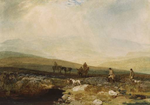Chelker Reservoir
Reservoirs in North Yorkshire

Chelker Reservoir is a man-made lake in North Yorkshire, England. It lies in the parish of Draughton, immediately north of the A65 road, between Skipton and the village of Addingham. It was put into service in 1866 and serves the Bradford area; it is currently owned by Yorkshire Water. The reservoir's main inflow is the River Wharfe.
Excerpt from the Wikipedia article Chelker Reservoir (License: CC BY-SA 3.0, Authors, Images).Chelker Reservoir
Skipton Road, Bradford Draughton
Geographical coordinates (GPS) Address Nearby Places Show on map
Geographical coordinates (GPS)
| Latitude | Longitude |
|---|---|
| N 53.95997 ° | E -1.91514 ° |
Address
Skipton Road
Skipton Road
LS29 0JU Bradford, Draughton
England, United Kingdom
Open on Google Maps











